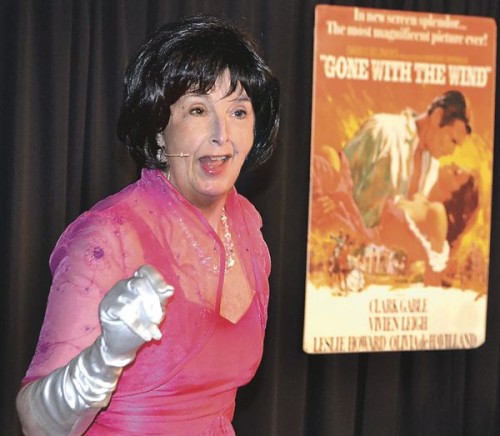
Debra Conner presented “Margaret Mitchell’s … Gone With The Wind” as the last entry in the 2015 Blennerhassett Winter Lecture Series on Sunday at the Blennerhassett Museum.
PARKERSBURG, W.Va. — A local living history performer recounted the life and times of the author of one of the most popular novels of all time Sunday at the Blennerhassett Museum of Regional History.
Debra Conner presented “Margaret Mitchell’s … Gone With The Wind” as the last entry in the 2015 Blennerhassett Winter Lecture Series.
Conner, portraying Mitchell, recounted tales of living in Atlanta in the early 20th Century and growing up hearing tales of Southern culture around the time of the Civil War that formed the basis for the novel, “Gone With The Wind” and its successful movie adaptation that was released in 1939.
Conner, as Mitchell, said she was somewhat overwhelmed by all the attention she got after the novel was published and again after the movie was released.
“I can hardly believe now that people see me as the incarnate spirit of the Old South,” she said. “I am, in truth, a product of the Jazz Age.
“I am one of those short hair, short skirted hardboiled women that the preacher said would go to hell or be hanged by the time she was 30.”
Mitchell grew up listening to stories of the Old South and of the Civil War.
“I grew up on stories of the bravery and gallantry of the men in Confederate grey,” Conner said as Mitchell. “I heard so many of those stories that I was 10 years old before I realized that the South had lost the war.”
Mitchell’s family believed that those stories were important, it was important to remember them and keep that history alive in some way. She also learned the value of a good education from her family in helping one to survive in a changing world. She collected many of the stories her family told and used many in her novel.
Although “Gone With the Wind” is a work of fiction, everything in it was based on fact and happened to someone, Conner as Mitchell said.
When she first started writing the novel, Mitchell had a number of chapters and scenes worked out, but nothing specific worked out that could be considered an actual manuscript. She had various notes and envelopes of written material that was collected. When the book was bought by a publisher, Mitchell had yet to write the first three chapters. She was paid $500 for the original book.
It took over a year of work and research to get the novel to a point it could be published. The book went on to win the Pulitzer Prize for literature.
The first line she wrote for the novel was “She had never understood either of the men she had loved and so she had lost them both.” The line ended up not in the beginning of the novel or the middle, but was on the next to last page at the end.
One early title was “Tomorrow Is Another Day.” The title “Gone With the Wind” came from a work by poet Ernest Dowson. Originally, the main character was going to be “Pansy O’Hara,” but the publisher did not like it and wanted some alternatives. Mitchell provided a list of 25 alternative names.
“Out of that list Scarlett was the 17th,” said Conner as Mitchell.
Conner, as Mitchell, discussed the production of the movie and some of the changes that were made. The famous line, “Frankly, my dear I don’t give a damn” did not appear like that in the novel. It was “My dear, I don’t give a damn.” The filmmakers thought “Frankly” added a certain offhand quality to the moment.
Even the word, “damn” had a hard time getting past the censors of the day and it ended up costing the producer David O. Selznick around $5,000 to keep it in.
In Parkersburg, the release of the movie “Gone With the Wind” was such a big deal that area school children were allowed to have the day off to go see it, presumably with their parents, said Ray Swick, historian for Blennerhassett Island Historical State Park and the museum.
Conner has performed a number of characters around the area over the last several years, including one closely tied to Blennerhassett Island, that of Margaret Blennerhassett. This spring she and her husband will be leaving the area and moving to South Carolina.
The performance Sunday was described as being “bittersweet” for the museum as Conner has given so much of her time to it by volunteering, Swick said.
“This will be her swan song here at the museum,” he said. “She is widely known as a living history performer since 1997.”
In addition to Mitchell and Blennerhassett, Conner has also performed as poet Emily Dickinson, Titanic survivor Edith Russell and Civil War surgeon Mary Walker among others. Swick said she is already studying the history of famous women around South Carolina so she can continue her work in her new home.
“Our loss is going to be South Carolina’s gain,” he said.
Conner has enjoyed her time being involved in presenting history in the local area.
“This has been an area that has just allowed me to give birth to this line of work,” she said. “The women I have chosen as my characters have always been so well received here.
“I have received tremendous community support for the work I have done.”
She is going to miss the area and its people.
“I keep reading the things people write about me and it is a little bit like reading my own obituary, but being around to hear these nice things,” Conner said. “I am going to miss the friendships I have here.
“That is going to be the hardest thing to part with. The friendships I have here will be irreplaceable.”
To read more from the Parkersburg News and Sentinel, subscribe here.





